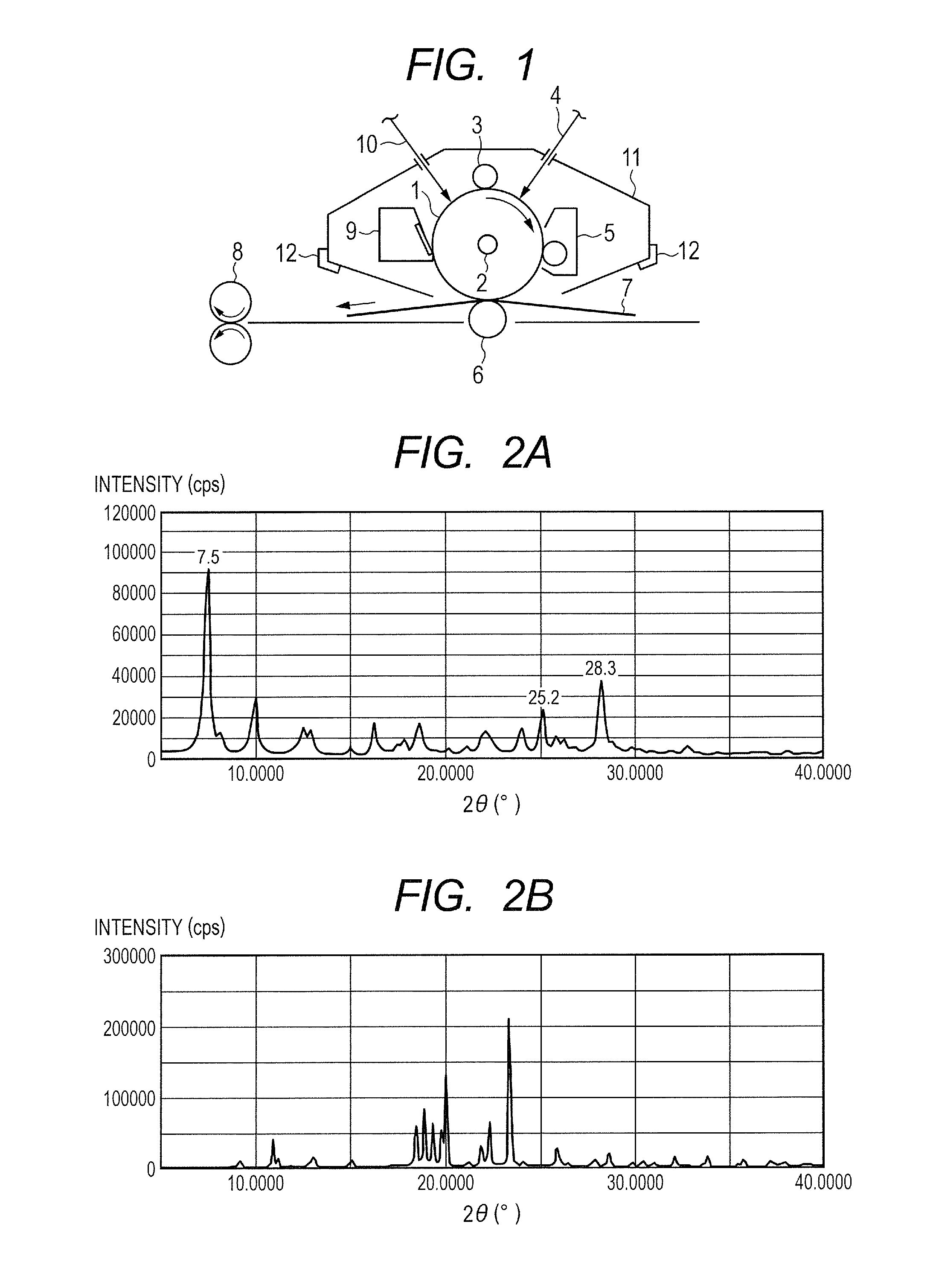Electrophotographic photosensitive member, method of producing phthalocyanine crystal, method of producing electrophotographic photosensitive member, process cartridge, electrophotographic apparatus, and phthalocyanine crystal
a photosensitive member and electrophotography technology, applied in the field of electrophotographic photosensitive members, can solve the problems of long-term electric potential variation, difficult to transform the additive into a desired crystal form, and produced photocarriers are liable to remain on the photosensitive layer of the electrophotographic photosensitive member, etc., to achieve excellent characteristics as a charge-generating substance
- Summary
- Abstract
- Description
- Claims
- Application Information
AI Technical Summary
Benefits of technology
Problems solved by technology
Method used
Image
Examples
example 1-1
[0135]0.5 Part of a hydroxygallium phthalocyanine crystal obtained by the same treatment as that of Example 1-1 subsequent to Synthesis Example 1 described in Japanese Patent Application Laid-Open No. 2011-94101, 1.0 part of Exemplified Compound (A-1) (product code: 159400050, manufactured by Acros Organics), and 10 parts of N,N-dimethylformamide were subjected to a milling treatment in a ball mill together with 20 parts of glass beads each having a diameter of 0.8 mm at room temperature (23° C.) for 40 hours. A hydroxygallium phthalocyanine crystal was taken out of the dispersion with N,N-dimethylformamide and filtered, and then the residue on the filter was sufficiently washed with tetrahydrofuran. The filter residue was vacuum-dried to yield 0.45 part of a hydroxygallium phthalocyanine crystal. FIG. 2A shows the powder X-ray diffraction pattern of the resultant crystal and FIG. 2B shows the powder X-ray diffraction pattern of Exemplified Compound (A-1) used here.
[0136]In addition...
example 1-2
[0138]0.45 Part of a hydroxygallium phthalocyanine crystal was obtained by the same treatment as that of Example 1-1 except that in Example 1-1, 1.0 part of Exemplified Compound (A-1) was changed to 2.0 parts of Exemplified Compound (A-1). The powder X-ray diffraction pattern of the resultant hydroxygallium phthalocyanine crystal was the same as FIG. 2A.
[0139]In addition, Table 4 shows an excerpt of TG data on the resultant crystal. As shown in the excerpt, a weight reduction amount increases in a range not less than 305° C., which is higher than the evaporation temperature of Exemplified Compound (A-1) alone (200° C. to 305° C.), indicating that Exemplified Compound (A-1) is incorporated into the hydroxygallium phthalocyanine crystal obtained in Example 1-2.
[0140]In addition, NMR measurement confirmed that Exemplified Compound (A-1) was incorporated at 0.82% into the crystal.
example 1-3
[0141]0.35 Part of a hydroxygallium phthalocyanine crystal was obtained by the same treatment as that of Example 1-1 except that in Example 1-1, 10 parts of N,N-dimethylformamide were changed to 10 parts of dimethyl sulfoxide. FIG. 3A shows the powder X-ray diffraction pattern of the resultant hydroxygallium phthalocyanine crystal.
[0142]In addition, NMR measurement confirmed that Exemplified Compound (A-1) was incorporated at 0.83% into the crystal.
PUM
| Property | Measurement | Unit |
|---|---|---|
| Bragg angles 2θ±0 | aaaaa | aaaaa |
| Bragg angles 2θ±0 | aaaaa | aaaaa |
| oscillation wavelength | aaaaa | aaaaa |
Abstract
Description
Claims
Application Information
 Login to View More
Login to View More - R&D
- Intellectual Property
- Life Sciences
- Materials
- Tech Scout
- Unparalleled Data Quality
- Higher Quality Content
- 60% Fewer Hallucinations
Browse by: Latest US Patents, China's latest patents, Technical Efficacy Thesaurus, Application Domain, Technology Topic, Popular Technical Reports.
© 2025 PatSnap. All rights reserved.Legal|Privacy policy|Modern Slavery Act Transparency Statement|Sitemap|About US| Contact US: help@patsnap.com



